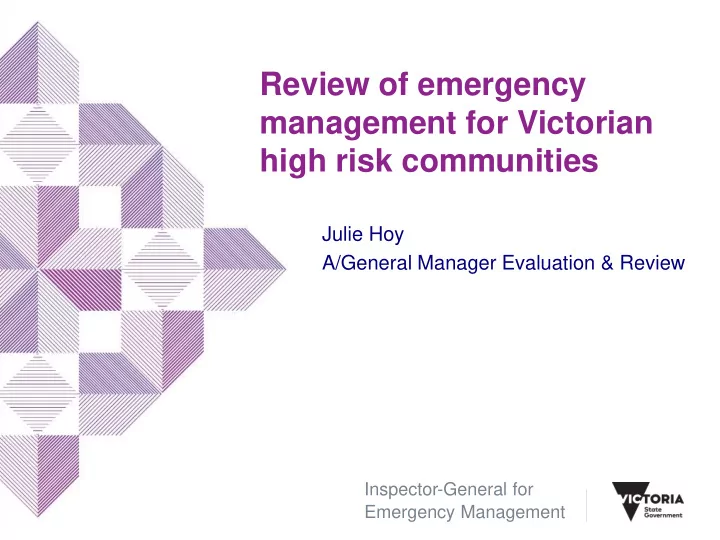

Review of emergency management for Victorian high risk communities Julie Hoy A/General Manager Evaluation & Review Inspector-General for Emergency Management
An overview of IGEM Emergency Management Act 2013 (The Act) IGEM established on 1 July 2014 by the Act Minister Performance Planned Implementation Requested Monitoring Reviews Monitoring Reviews • Provides assurance to government and community regarding the emergency management arrangements in Victoria and fosters continuous improvement of those arrangements IGEM • All assurance activities across the state are guided by the principles outlined in the Assurance Framework • The Act contains provisions relating to the public release of IGEM reviews
Review of emergency management for high-risk Victorian communities Identified in the 2017 Annual Forward Plan of Planned Reviews Reviews Review Aim Identify and assess current arrangements in Victoria’s emergency management sector for identifying, preparing and protecting high-risk communities. This includes the identification of opportunities for improvement in line with leading practice.
Review history 2017 Delayed start after Coolaroo recycling plant fire 2017 Literature review finalised Jan - Feb 2018 Stakeholder interviews Feb - Mar 2018 Community survey Mar - Apr 2018 Focus groups June 2018 Delivered to Minister Now The Minister seeking response from agencies
Stakeholders 21 stakeholders contributed to this review Local Community Responders Other EM Government Government Service
Methods and processes Background Environmental Scan Lines of Enquiry Stakeholder Community Community Focus Third-party Lit. Interviews Survey Groups Review Analysis Findings & Observations Develop Recommendations
Literature review objectives Define High-risk (HR) individuals Leading practice / communities Relationships: High-risk, Barriers and enablers for vulnerability and leading practice resilience For Victorian hazards: Identify metrics for • How to identify HR evaluating activity / communities programs for HR • Outline elements of preparedness / response strategies
Literature review findings – definition Individuals and communities who have Define the potential to be adversely affected High-risk (HR) individuals / communities by a disaster or emergency and who, because of the circumstances in their everyday lives, require significant and coordinated priority intervention, response and support from a variety of government and non-government organisations and the broader community for their safety.
Literature review findings – barriers • Focus on community resilience has decreased attention on Barriers and enablers for leading practice high-risk individuals and communities. • Command and control culture is inadequate for a collaborative and participatory approach with non-government stakeholders who can provide valuable experience and insights into the characteristics and needs of those at high-risk from hazards.
Literature review findings – gaps Identifying and assisting in The definition of vulnerable preparing for emergencies and persons (Vulnerable Persons building the adaptive capacity of Policy) is inadequate for the those at high-risk from hazard broad purposes of emergency does not fit with the focus on management planning community resilience. CSOs involved with high-risk High-risk individuals and individuals and communities communities are not adequately cannot adequately contribute to identified on a spatial or socio- emergency management sector economic level within the initiatives to engage and support Victorian population. those at high-risk from hazard.
Survey findings Limited awareness of vulnerable people 19% • < 50% of participants were HR individual aware of people who are ‘limited in their ability to respond to an emergency’ ▪ 19% believe they have limitations ▪ Most believe vulnerable individuals receive moderate or large amounts of assistance ▪ Over one fifth do not know how Aware of person with HR much assistance vulnerable Not aware of person with HR individuals receive
Survey findings • More likely to discuss their EM needs, Those who especially with neighbours or friends believe they • More likely to have arrangements in have limited place to respond to emergencies and ability to to have used them respond to an emergency • Perceived arrangements are adequate because: (~19%) ▪ they were able to look after themselves ▪ the emergency services assisted ▪ they chose to evacuate
Survey findings Emergency response limitations • Looking after children and pets • Medical conditions • Disability • Lack of mobility • Peri-urban and rural LGA residents saw bushfire and grassfire as a threat • Residents of urban and rural interior LGAs were concerned about heatwave.
Survey findings Bushfire, grassfire and flood arrangements were primarily People with a limited evacuation, having a ability to respond to plan and equipment an emergency = more likely to make arrangements to respond to a bushfire or storm event than those with no limitations Flood involved seeking assistance from neighbours and the emergency services.
In summary • Many sector initiatives, partnerships and research projects related to vulnerability and high-risk community. • The “all communities, all emergencies” approach, and the community focused approach to emergency management has identified that the sector has many foundations to support leading practice for high-risk communities in emergency management. IGEM thanks all of those who contributed to the review and looks forward to its release.
2019 – 10 years of reform in emergency management sector Victoria Review Sector Local Community Planning Workshop Government Views Annual 2019 Government Forward Plan Review department of Reviews: Commences collaboration Final scope
https://engage.vic.gov.au/emergencymanagementreform
Contact Contact Julie Hoy on julie.hoy@justice.vic.gov.au 8684 7914 Twitter @IGEM_Vic Web igem@vic.gov.au
Recommend
More recommend